conference



























On Nov. 6, members of the Future Businesses Leaders of America (FBLA) club participated in the Korea Busi ness Competition (KBC), a virtual competition where six teams of students design business ideas based on a given prompt. They were then judged by experts from vari ous fields while competing against other international schools.
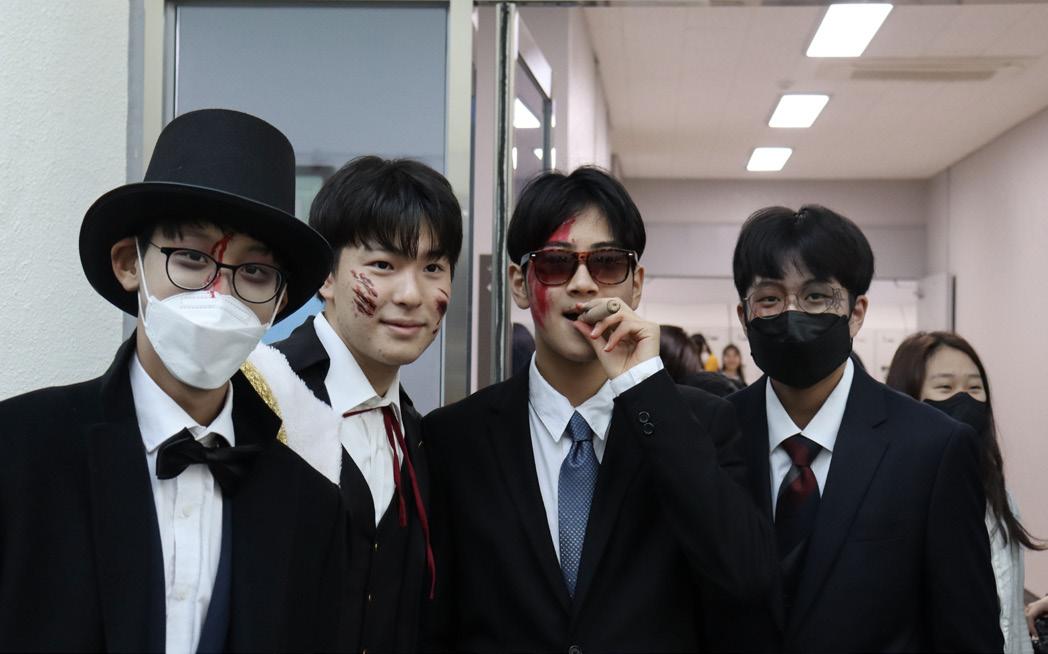
“I am very happy as a teammate,” Grace Choi (10), FBLA member, said. “I really appreciate every member’s effort in preparing their presentations for the competi tion.”
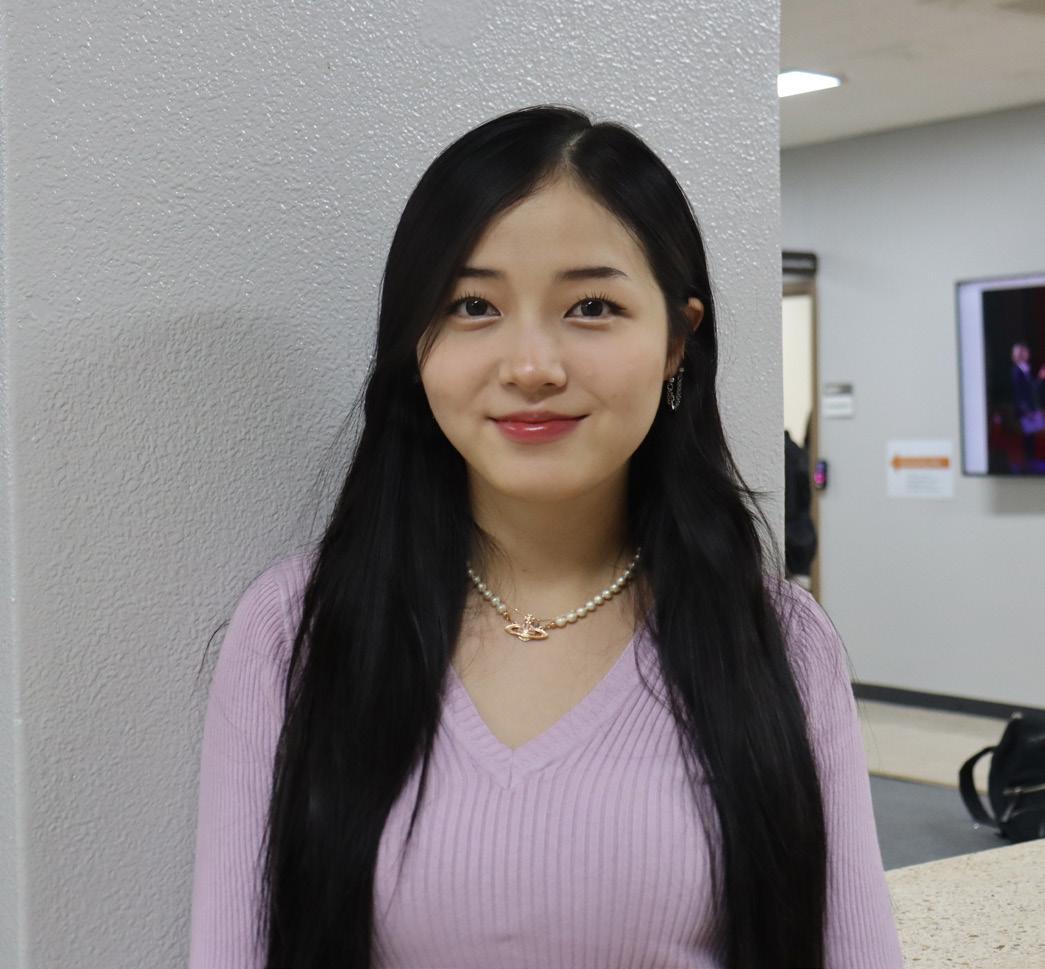
This competition requires a large amount of research, as their ideas are judged based on their creativity and practicality. SIS students have managed to maintain their solid reputation from exceptional results in previous competitions by achieving 1st place, 4th place, and 5th place in this year’s competition.
On Oct. 28, the HSSC hosted a Halloween costume contest in the atrium. Contestants posed on stage to show off their costumes to the judging panel including Morgan Miller, Nathan Warkentin, Megan Mannell, Glen Monaghan, and James Kowalski. Each judge rated the costume out of 10, and Rachel Yoon (12) won 1st place with her Batgirl costume.
“I was delighted by how many students dressed up,” Mr. Kowalski, contest judge and AP US History teacher, said. “I had an over 90 percent rate for my own students and some really great imaginative costumes. I think Hal loween is about having fun, and we’re in school, so if we can learn while we’re having fun, all the better.”
Students who take AP Seminar, AP Art History, AP Biology, AP Spanish, Spanish IV, or AP US History dressed up as figures or concepts related to their subjects to earn extra credit, inspiring more people to dress up for Halloween.
In early July, students eagerly awaited AP scores for the 2021-’22 term, with many hoping to receive 4s and 5s on the tests. After all the anticipation, however, a certain student who had received a perfect score on Sept. 17 smiled, receiv ing an email that she had not missed a single mark on the AP Drawing exam.
“When I first received my score, I was pretty shocked,” Clare Kim (12) said. “I was really excited to see that I had received the maximum points possible, because I knew that not many people were awarded such scores. It was even more shocking because I had worried that the examiners would be split on the content and drawing techniques pres ent in my artwork, but I realized my fears were overblown.”
Clare’s score is a culmination of the high level of skill and effort she has put into the course, going beyond the score necessary to receive college credit and being, as the College Board states, “well-qualified.” This year, only 343 out of approximately 19,000 students worldwide received such a score for AP Drawing, and only a few SIS students have received full marks on their AP exams since the school’s inception, with even fewer cases for the AP Drawing exam.
“It’s extremely rare for students to achieve this feat,” Hannah Ireland, Head of the Art Department, said. “AP Drawing is a highly challenging course that requires stu dents to have the strongest work ethic and go to their teach ers for more feedback to improve their pieces, which makes it time-consuming with the original creation of a piece and its refinement. Combined with how art in itself is rather subjective, it is all the more difficult to get a perfect five.”
Since a perfect score is such a rare occurrence, students at SIS should ensure that they put in the most effort to get as close to perfect as possible. Because of its rarity, occur ring for only 1.8 percent of students this year, it is a notable accomplishment that helps distinguish students from even those who work tirelessly to achieve a 5.
“Only five people have ever received a perfect score in SIS’s history,” said Gray Macklin, SIS’s AP coordinator. “Three have been for AP Drawing, meaning that SIS has nur
tured 1 percent of 343 perfect scorers. Two of the students have now graduated, and one is a current senior—Clare.” With this in mind, Clare shared some tips and tricks on what students should consider when creating and submit ting their final AP Drawing portfolios.
“Even if the process of creating art is time-consuming, students should never give up,” Clare said. “It is always hard to come up with completely new ideas and pieces on a strict time schedule. But to maximize productivity, I think the best way is to do extra touch-ups on pieces at home and to start the brainstorming and sketching process as soon as possible to get quick feedback from the teacher, as time is usually the biggest issue for art students.”
By: Grace Lee Junior, reporterOver the past few weeks, all SIS fall sports teams—vol leyball, tennis, cross country, and Forensics—participated in the annual KAIAC tournament.
On Oct. 22, when SIS hosted the JV girls volleyball tour nament, SIS emerged victorious, beating OMHS in the final game.
“The KAIAC tournament was very nerve-racking at first because it was the first school competition I had ever partic ipated in,” Stella Eu (9), JV girls volleyball player, said. “It was very fatiguing, both physically and mentally. But the more games I played, the less nervous I got and the more focused on winning I became. So when we did win, it was extremely satisfying, especially because of all the hard work we put in.”
country team also had a remarkable achievement ear lier in the semester, as they became KAIAC All-Conference Champions, ending a 21-year drought of victories.
“This season was definitely one to remember. It was my first year on the team, so I didn’t really know what to expect,” Terry Seong (10), varsity boys cross country runner, said. “However, I was blown away with what we were able to accomplish this year, especially by snapping the 21-year drought in KAIAC. By the time the season had ended, I was extremely satisfied.”
On Nov. 1, the ES department unveiled the new ES library, which has been redesigned to make learning more interactive and accessible. Students attended an official opening ceremony, getting the chance to see the newly designed library for the first time as before they had a temporary library called the ES Pop-up Library.
New additions to the library include a Lego wall, magnetic boards, additional cozy spaces, a separate classroom space, screens, collaborative booths, a virtual library, and bar seating. The separate classroom space allows multiple classes to be in the library at once with out disturbing each other.
“The library was designed to be a flexible space for learning,” Johanna Schooley, ES librarian, said. “Students can come in, read, inquire, and discover through the books and resources we have as well as through inter active play.”
By: San Schwede Sophomore, reporterThe varsity boys and girls volleyball teams had their KAIAC Cup Tournament from Oct. 28-29, with the boys team traveling to YISS and the girls team traveling to DSS to par ticipate in the event. Unfortunately, the girls team suffered losses to OMHS and Chadwick International in the KAIAC cup, placing 7th overall.
The boys team started out strong, beating TCIS in the first round. However, they fell short, losing to SFS in the semifinals and placing 4th overall. In a more positive light, the varsity boys team was able to win the KAIAC All-Con ference Championship after beating KIS on Oct. 21 with a set score of 3-1.
“I am extremely proud of our team this season.” Glen Monaghan, varsity boys volleyball coach, said. “Though the tournament itself did not turn out the way we wanted, we still had a very successful year, I had a lot of joy with this team, and I am looking forward to continuing to coach the new varsity boys next year.”
On Oct. 29, both varsity cross country teams traveled to SFS to participate in their KAIAC tournament. The girls started off the tournament with their race, eventually plac ing 6th overall. The boys race then followed, in which they placed 3rd.
Notable runners include Paul Moon (11), who individu ally placed 4th. The varsity boys cross
The varsity tennis teams had their KAIAC tournament on Oct. 28, with the girls traveling to Chadwick International and the boys traveling to SFS. The boys team emerged vic torious from their tournament, placing 1st. Notable players include William Kim (12) and Eric Kim (12), who went unde feated in their singles games.
The girls team also posted great results, finishing 3rd in the tournament. Notable players from the girls team were Amber Cheun (12) and Seojin Park (11), who also went undefeated in their singles games.
“I think I speak for both tennis teams when I say that we are extremely proud of our players’ results this season,” Ross Atkins, varsity boys tennis coach, said. “Especially for the boys, although we were confident that we had a good chance at winning, it wasn’t a result we went into the tournament expecting. Our goal was to just play the best we could, which then led to great results, as multiple players even went unde feated in their individual games.”
The Forensics team also had its first in-person tourna ment in over two years on Oct. 15, coming out the weekend crowned champions. With the winter season now in session, SIS athletes hope to continue these victorious results into the new season, with the KAIAC tournament to be held in early February.
By: Yoon Choi Sophomore, reporterOn Oct. 28, GIN hosted its annual Halloween Carnival in the annex building. From 3:30 to 7:30 p.m., club members organized several activities for students to participate in, including a haunted house, food sales, board games, cup pong, photo booths, and face painting. Taking place on a Friday, the Carnival gave students the opportunity to relax and spend time with friends before their weekend.
“The purpose of hosting this Halloween Carnival was to raise Halloween spirit for both middle school and high school students while allowing people from different grade levels to bond and have a great time,” Sahngwon Lee (11), GIN club treasurer, said. “We were able to come up with various ideas for games to host at this event as we discussed in numerous meetings to decide which games would be the most appealing for the students.”
An estimated 200 students appeared at the event in a vari ety of costumes. Some dressed up as fictional characters like those from the “Harry Potter” series or the “Matrix” movies, while others dressed as historical figures to get extra credit for their AP classes.
The annex building itself was furnished with several Hal loween decorations to set up a proper mood for the Carnival. Inside, there were several sections that hosted a variety of activities. For example, there was a photo booth that was elaborately decorated for the students to capture the mem ories they made that day and get high-quality pictures from members of the Aperture photography club.
“I thought the location was really good as it was really open, splash-resistant, and easy to navigate,” Gray Macklin, Halloween Carnival attendee, said. “The venue was really good for socializing, and the tables that hosted activities were also a really good organization and addition to the Car nival. I think it was especially fun for the middle schoolers.”
As tensions rapidly escalate into larger international con flicts, influencing trade and global supply chains, members of the SIS MUN Club debated upon such issues at the 25th iteration of the annual SEOMUN conference, hosted virtu ally by SFS on Nov. 11-13 based on the theme “connecting the world through Bonds of Unity.”
“The theme for this year’s conference fit current events as we have seen a rise in international tensions, such as the Russia-Ukraine War that has had a rippling effect on the world,” Eric Cho (10), Deputy Assistant President of the Six Party Talks committee, said. “But it is also important to bring awareness to issues outside of Russia and Ukraine, which is why I think the agenda ‘Implementing measures to prevent the escalation of territorial disputes in East Asia’ that my committee debated upon was also relevant.”
The SEOMUN Secretariat emphasized the significance of their theme, as this year’s logo seemed particularly unique. Depicting two people facing each other and shaking hands, the SEOMUN XXV logo was created in partnership with the artist DUK to demonstrate how the conference prioritizes peaceful cooperation among all delegates, chairs, adminis trators, and supervisors.
While the theme matches the current state of events, many participants of SEOMUN XXV found it unfortunate that COVID-19 restrictions were not uplifted, taking place virtually for the third year in a row. Before the COVID-19 pandemic, SEOMUN had been held at COEX Mall, where many students formed more personal connections and created unforgettable memories.
“I remember attending SEOMUN during middle school as one of the admin members,” Sahngwon Lee (11), President of the Economic and Social Council, said. “At the time I had imagined that I would be making a speech at the convention as a junior, so it was a bit upsetting that I spoke in front of a screen for the second time. I hope I will finally be able to live out my dream next year when SIS hosts the conference.”
Despite the unfortunate circumstances, SIS MUN mem bers prepared diligently during practices by members participating in mock debates and practiced impromptu speeches to simulate the volatile flow of discussions. With such preparations, many members were recognized for their performances during the awards ceremony.
“I think practicing impromptu speeches was the best form of preparation for me because I struggle with thinking on my feet,” Jian Hong (9), honorable mention recipient of the United Nations High Commissioner for Refugees com mittee, said. “I felt more confident and prepared during the conference because I stumbled over my words less.”
But MUN members were not the only ones who made persistent preparations. Members of Seoulite, the SEOMUN press team, also worked hard behind the scenes to create
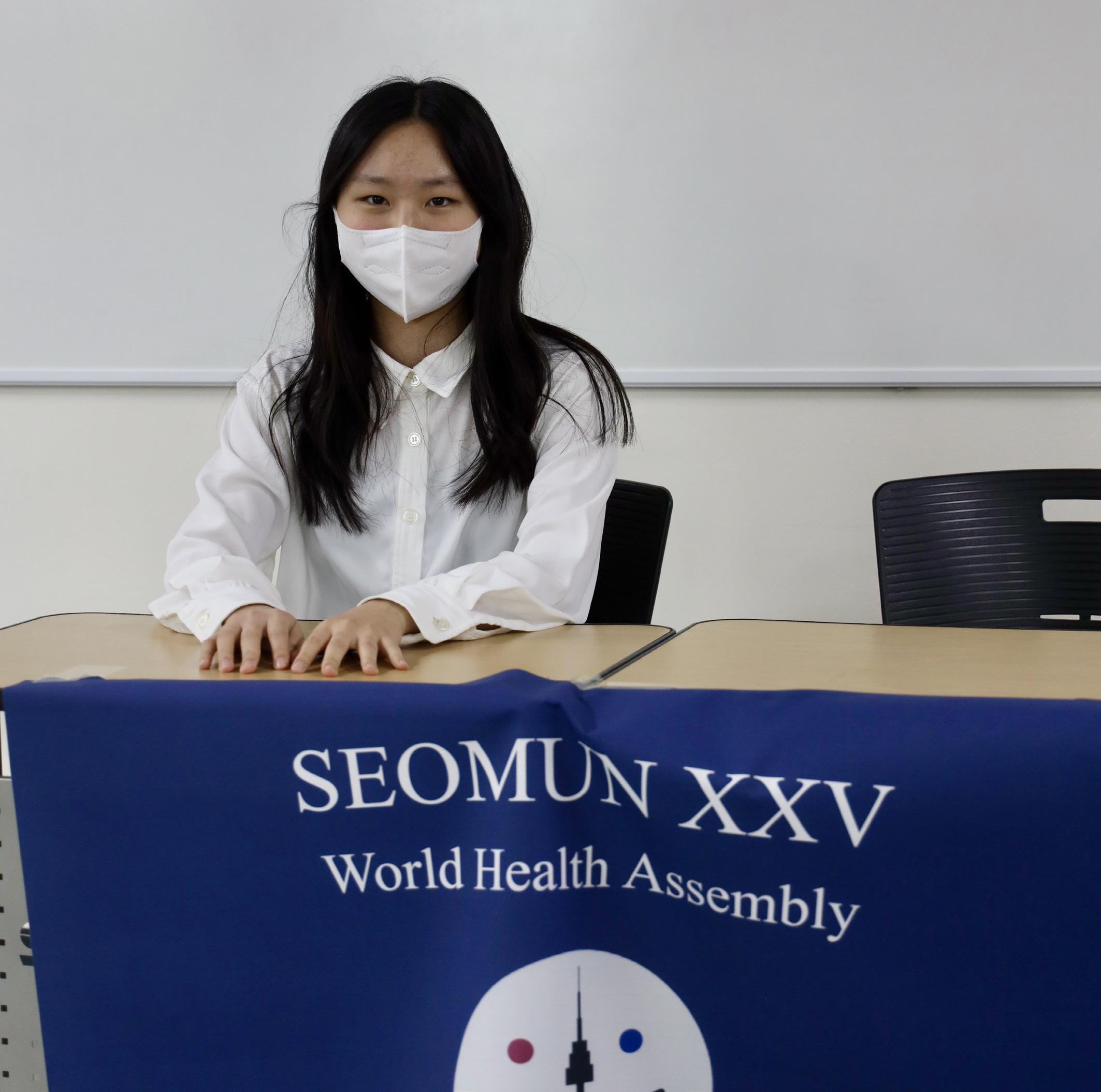
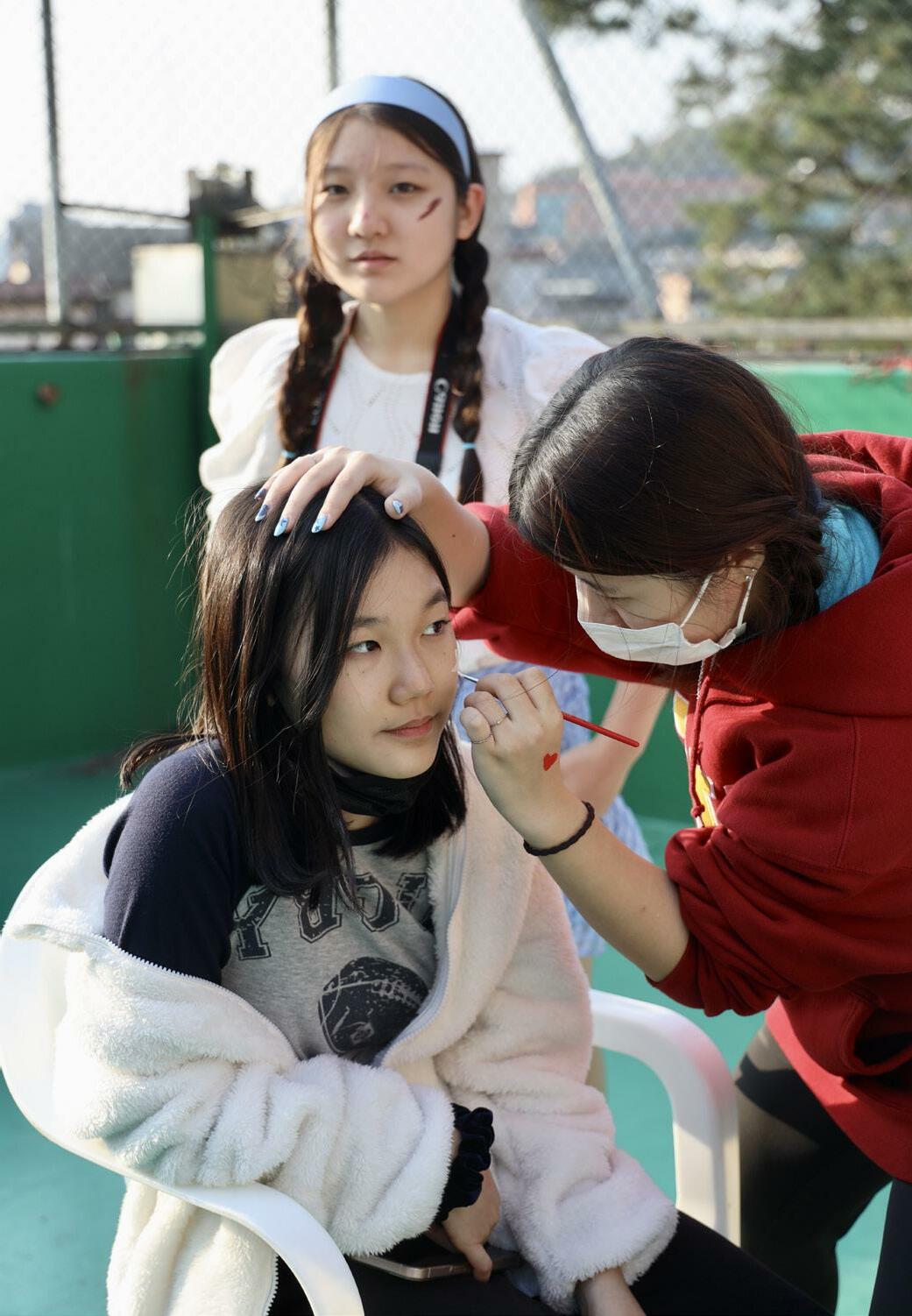 By: Jasmine Jeong Senior, reporter
By: Jasmine Jeong Senior, reporter
Students were able to enjoy a wide array of food with sales of pizza and ramen allowing students to have snacks in between the activities. Students could also visit the face painting table, where they got to choose designs and show them off to others.
“I really enjoyed the Halloween Carnival because it helped reduce the stress from all of the college applications and tests I had this week,” Sally Lee (12), another Halloween Carnival goer, said. “I do think it could be improved if they brought back the horror movie section like they had last year, which I remember I enjoyed a lot. Also, selling Hallow een-related candy would have been really nice.”
For high school students, this event was an opportunity to socialize and unwind from all the work they had during this week. For middle schoolers, it was a chance to interact with high school students and get a glimpse of high school club activities. They both got to experience creative costumes, enjoy the haunted house, and make special memories with their friends. Overall, the Halloween Carnival proved to be a valuable experience for both middle and high school students.
“We spent about 800,000 won and 3 weeks of planning in order to prepare for the Carnival,” Ewan Huh (12), GIN club president, said. “Our club members put in all their effort and time to host this fun event. Overall, the Carnival was very successful, as we earned a profit and created an event that high and middle schoolers could enjoy.”
By: David Kim Junior, reporterthe best designs for their issues.
“We kept brainstorming layouts and graphics we could possibly incorporate into our work throughout the entire conference,” Julie Ko (9), member of Seoulite, said. “We were also busy visiting different rooms to try to get as many photos of everyone as possible.”
With bonds of unity accurately reflecting current events and the essence of MUN, but also persisting among the SIS MUN club, Seoulite, and all participants of SEOMUN, it seems like SEOMUN XXV was a success.


On Sept. 15, the US Food and Drug Administration (FDA) issued a report regarding dan gerous social media challenges involving medicine. One par ticular challenge that the FDA warned against was the “NyQuil Chicken Challenge,” in which various social media users had reportedly encouraged cooking chicken in the cold medicine NyQuil, claiming that it aids in fighting illnesses. Over the fol lowing two weeks, numerous news outlets in the US discussed the issue, with most reporters scoffing at the absurdity of mod ern-day teenagers and criticizing the harmful effects of social media.
However, hidden beneath the supposed credibility of the larg est news organizations in the US, a concerning truth was revealed: the NyQuil Chicken Challenge
only became a problem once the media falsely portrayed it as one.
The challenge itself finds its origins in 4chan, the social media platform notorious for being a hub for Internet trolls, where an anonymous user posted a recipe for “Sleepytime Chicken” in 2017. This concept later spread to platforms such as TikTok and Twitter, where its satirical nature was kept intact, with most indi viduals mocking the dangerous, nonsensical meal.
Until mainstream news plat forms picked up this story, there had been no reported cases of any individuals actually attempt ing this trend and harming them selves. Even the FDA report that the media portrayed as a specific appeal against the challenge only mentioned NyQuil a single time, instead discouraging the irre sponsible use of drugs on social
After many months of political stag nation since his inauguration in May, President Yoon Suk-yeol is making his first major initiative. On Oct. 6, the Yoon administration announced that it would ask the National Assembly to abolish the Ministry of Gender Equal ity and Family. Pending the National Assembly’s approval, the proposal aims to officially shut down the decade-old Gender Ministry and transfer some of its roles to other branches, including a new organization in the Ministry of Health and Welfare.
While the Yoon administration has endorsed its plans for abolishing the Gender Ministry as a necessary meas ure for the more effective protection of women’s rights, others have criticized the plans as being harmful for Korean women.
“At first, I was a little dismayed that Yoon would abolish the entire gender ministry, as I thought that would pose a huge risk for women’s rights,” Eric Chang (12), Korean politics enthusiast, said. “But the more I thought about it, I came to realize that the gender minis try did not really contribute effectively in protecting women’s rights and pro moting opportunities for women.”
The plans are a product of many months’ consideration. Starting from his campaign pledge earlier this year, President Yoon has constantly voiced strong opposition to the current Gender Ministry and promised major changes. Two months after his inaugu ration, Yoon announced the initiation of plans for abolishing the Gender Ministry. Now, the abolition is only a few votes away from being enforced.
“In a regional context, this is a rather unique development as the general trend in Asia is that countries are get ting more progressive and supportive of women by creating specialized gender institutions,” Steve Nave, Con temporary Asian Studies teacher, said. “But considering the rise of anti-femi nism in Korea and the wary political climate toward liberal initiatives, this shift to traditional Korean conserva tism by abolishing the gender ministry and incorporating its responsibilities into the more conventional Ministry of Health and Welfare is not too sur
layout by San Schwedeprising.”
media in general.
Not only did the media com pletely misinterpret the FDA report, but many platforms also misused evidence of this chal lenge being attempted, purpose fully misleading the audience to attract more attention. The clip that was used for several broadcasts from popular news channels such as ABC11, NBC, and CNN was posted by TikTok user @igrobflo on Sept. 4, 2020. Many pointed out that the video was blatantly satirical, with the person recording using a hair straightener to flip the chicken and ending the video with the joke phrase “Bone Apple Tea.” However, most news channels cut out such telltale signs of irony, muting the audio and instead citing the footage as evi dence of the rise of dangerous social media trends influencing
the younger generation.
The sensationalized and exag gerated lies spread by popular news platforms are clear exam ples of improper journalism that works to disinform, rather than inform, the public. However, even more concerning than the prob lematic direction toward which American news culture seems to be headed is that this misinfor mation drew more attention to the NyQuil Chicken Challenge, turning it into a real issue of interest.
Considering that the plat forms spreading this erroneous information are some of the largest news sources in America, the wide-ranging consequences of such improper journalism are clear. This problem also alludes to a possible reason trust and interest in the news in the US have continuously declined
over the past few years, with Reuters reporting that only 42 percent of people claim to trust news most of the time, and 38 percent of people saying they often avoid the news entirely.
In the age of information, where both the truth and lies can be spread rapidly throughout a massive population, journalists and news platforms have the duty to become a trusted source of information that fosters an informed, rational public. How ever, this cannot be achieved if news platforms continue to pander to an older audience, crit icizing the younger generation and promoting a myopic view of the consequences of social media instead of embracing technolog ical advances and providing an impartial, comprehensive view point.
While Yoon’s promises to abolish the Gender Ministry likely factored into his successful election, the plans are draw ing significant controversy. The Yoon administration and its supporters criti cize the supposed ineffectiveness of the Gender Ministry, pointing out cases where the ministry failed to fulfill its duties, such as its failure to respond to accusations of Seoul Mayor Park Wonsoon’s sexual abuse. On the other side, opposers of the abolition have called out the plan as a devastating blow to women’s status and rights in Korean society, citing the major contributions of the Gender Ministry toward estab lishing gender equality.
“I am strongly against Yoon’s plans as I believe they will be ineffective,” Jennah Yoo (12), avid follower of Korean politics, said. “I think the very fact that the Gender Ministry’s roles are being allocated to other branches of the government shows how important the Gender Ministry is. While I am uncer tain whether the plans pose a hazard to women’s rights, it definitely shows Korea’s strong patriarchy.”
Another major criticism of the abo lition plans is that they are supported overwhelmingly by unemployed young men who believe their financial situa tion is caused by the Gender Ministry’s additional support toward women. Indeed, many claim that the abolition is motivated by political incentives aimed at capturing the support of the young male demographic and antifeminists.
“In the past few years, there has been an alarming increase in hostility toward feminism in Korea,” Morgan Miller, Government and Politics teacher, said. “This is especially true among young, unemployed men, the number of whom are increasing, who believe that their circumstances are due to women getting additional gov ernment support. Yoon likely proposed the abolishment of the gender ministry to attract the votes of this demographic as well as older conservative men who are wary of feminism.”
BY: Hugo Lee Senior, Copy editorOn the night of Oct. 29, a crowd crush in the district of Itaewon in Seoul killed at least 156 people and injured 172 people. With more than 130,000 visitors there to celebrate Hal loween or simply enjoy their weekend, Itaewon was quickly overcrowded, and the move ment of the crowd flew out of control.
In one narrow alley, the lack of coordination among people and crowd control measures caused those in the front to col lapse, creating a domino effect. As more people piled onto each other, many at the bottom of the heap had difficulty breathing, causing unconsciousness and death.
“When I left Itaewon at 6:30 p.m., Itaewon station was already beyond packed,” Pat rick Young, Itaewon visitor on the day of the crush, said. “It was crowded to the point that I could not move. The next day, I had to go down to Itaewon again for a doctor’s appoint ment, and seeing all the yellow tape was definitely alarming. I still do not understand what happened: how did more than 150 people die?”
Mr. Young has been to Itae won almost every year for Halloween, which he views as a very entertaining, unique event in Korea in which people take pictures and have a nice time together. Though he says
Itaewon during Halloween has always been dangerous, he believes it must have been twice as crowded this year.
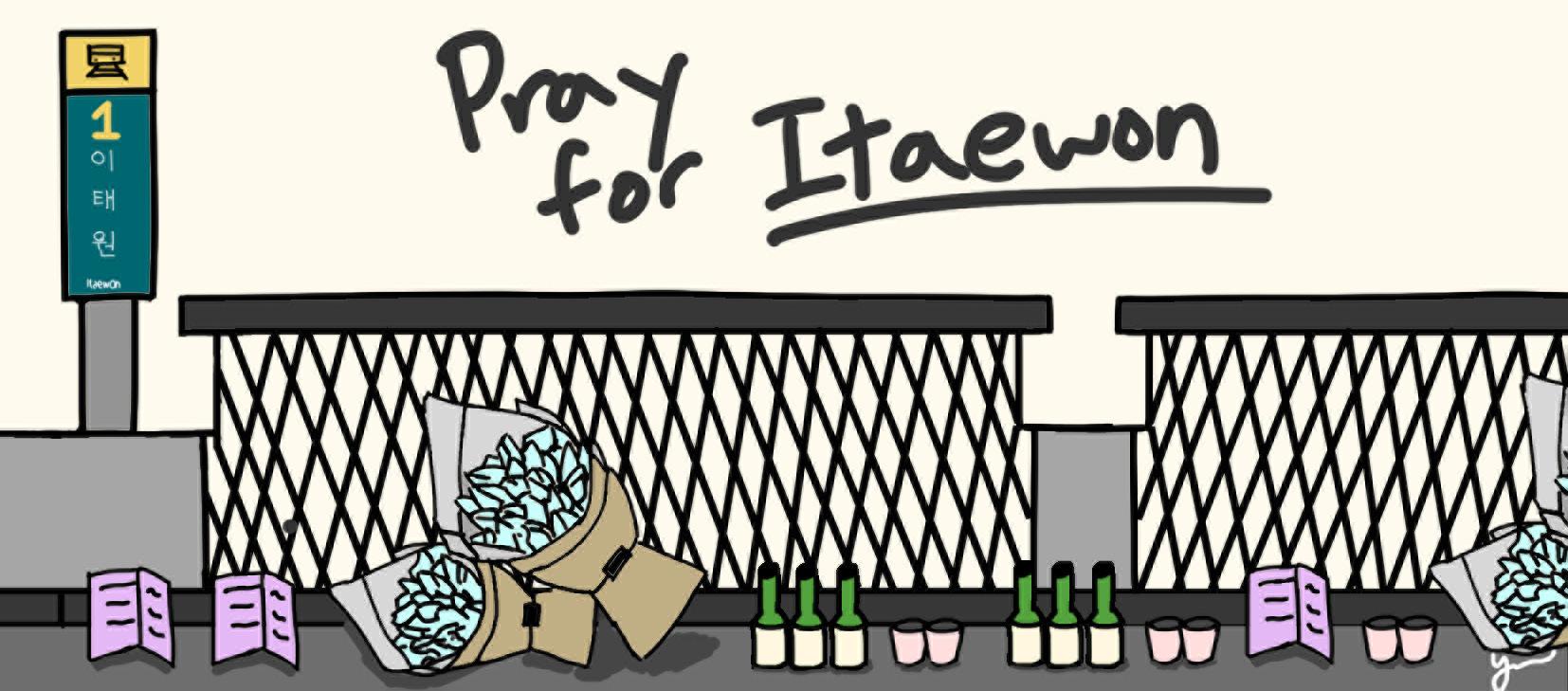
Itaewon, a multicultural district, is a place in Seoul that many SIS students and teachers like to visit frequently. Yet, the fear and trauma that survi vors, rescuers, and witnesses experienced from the crowd crush suppressed some of their desires to visit Itaewon.

“I could not really sleep over the past few days as memories of seeing the dead bodies made me fear that something similar might happen to me,” Elena Kim (11), witness, said. “From 11:30 p.m. to 12:30 a.m., I visited Itaewon for the first time with my sister to have fun, and we did not know that many people would be there to celebrate Hal loween. We avoided the crowd as people around us warned us not to go. We saw ambulances and a few corpses, and this is still traumatizing me. I don’t think I will ever go back to Itaewon again, and I am also hesitant to visit crowded places now.”
Many point out that the inci dent could have been prevented with a more prompt response from the Korean government and police authorities. Police authorities such as the chief of police did not quickly dispatch more units after receiving 79 calls from citizens.
“I did not see many police officers at that time,” Elena said.
“But I actually do not think that the incident would have been completely preventable even with police control because it is difficult to manage large crowds when people do not listen to the police.”
Outside of Itaewon, the crowd crush has had lasting consequences with not only Halloween activities but also festivals and concerts being canceled amid the national mourning period declared by President Yoon Suk-yeol on Oct. 30. Many Koreans, even those who were not at Itaewon on the night of Oct. 29, are increasingly worried about visiting highly crowded places, such as sub ways and concerts.
“I was at home at the time of the crush, and I got many emergency messages on my phone and heard many ambu lances on the streets,” Allison Lee (11), nearby resident, said. “Although I was not at Itaewon, I was still close by. I realized that these types of accidents may happen to anyone at any time, and I hope our society can better cooperate to prevent such tragedies from repeating in the future.”
BY: John Kim Junior, reporterFor decades, video games have been regarded as one of the most interesting creative mediums, as brands such as Nintendo, Sony, Blizzard, Activision, and Electronic Arts carved themselves out as household names. To achieve this success, these developers would create a myriad of games that any individual could play, but games that every individual could have a completely different experience playing. Video games were the pinnacle of escapist media in the 2000s and 2010s, as players could immerse themselves in an entirely different world, make their own choices, and live with the conse quences of those choices in whatever context the game was in. Recently, however, video games may have lost their magical properties, as massive triple-A game studios have begun to realize that as long as they pump out as much content as possible—regardless of the quality of the games—they can still make large profits.
This has led to some of the biggest names in video games putting out unpolished and sometimes borderline unplayable products on launch day, with the mindset being that they can simply patch them out later into playable products as time progresses. One of the most notorious examples of this practice in recent memory was the release of “Cyberpunk 2077,” one of the most anticipated games of the 2010s going into the early 2020s. The game, which took several years of development, was extremely ambitious in its scope and positioned itself to be the most realistic game of all time. However, as the hype for the game waned while development edged closer and closer to hitting the ten-year mark, the developers were forced to simply release the game in an extremely unfinished, buggy state.
When players loaded into the long antic ipated game, they realized how poorly made and optimized the game was. The game would frequently crash, player models would not load in properly, and certain game mechanics would not function as intended. This resulted in the
Playstation store offering refunds to anyone who had bought the game for a full month after the game’s release, simply because the game was so unfinished that customers did not deserve to pay the $60 price tag. Examples such as this created huge media fiascos, where the player base implored the studios to stop this practice, but the trend has not stopped.
Overall, this trend has been harmful to the video game community. It is extremely detri mental to the creative process and the overall quality of the game industry, as it inspires more and more big video game studios to create sell out products. However, aside from all of the negatives, this trend has, in a way, put indie game developers in the spotlight.



Indie games, despite their comparatively lower prices (around $25 per game to triple-A studios’ $60-70), generally put out more pol ished products with richer storylines and inno vative mechanics.
This has resulted in certain indie games attracting cult followings, such as with the game Shovel Knight, a massively popular indie game that has earned the love of its commu nity by creating beautiful 8-bit graphics and a unique set of controls unlike any other game. Such indie games have reignited many players’ love for video games, which had been dying out due to the reprehensible means of production that the biggest developers employ. Although the trend has been generally harmful, it has given the spotlight to smaller developers and provided them with more opportunities to stand out.
The mainstream video game market is declining in quality, which hurts the players and the video game catalog. However, as long as this practice is making video game studios money, it is not going to stop. And so, if one feels disengaged with the recent video game titles being released, it is time to step away from supporting the sellout triple-A studios and move closer to the indie studios.
The recent Netflix show “Monster: The Jeffrey Dahmer Story,” released on Sept. 21, has been one of Netflix’s most viewed yet also one of its most controversial shows in years. Deviat ing from traditional true-crime doc umentaries, the show portrays the story of serial killer Jeffrey Dahmer through a biographical narrative.
The show follows his life from his perspective, including scenes from his tragic childhood all the way up to his death. In a time where truecrime has become a popular genre, the show has been received as one of Netflix’s biggest hits, on par with popular shows like “Squid Game” and “Stranger Things.”
“I found the show to be kind of unique and different from other crime shows,” Keanu Park (10), show watcher, said. “I think it also does a good job dramatizing and intensify ing certain scenes in the show that were meant to be taken seriously.”
However, the show has faced sev eral setbacks. Originally intended to inform people of a gruesome killer by raising awareness of the Dahmer case, the show has been criticized for sensationalizing a tragedy: brutal scenes are recreated to disturbing detail, while the plot’s emphasis on Dahmer’s rough childhood portrays Dahmer in a sympathetic light.
“I first heard criticisms of the show on social media, and while initially I didn’t think much of it, some issues started to get clearer as I watched the show to the end,” Sean Kim (10), show enthusiast, said. “But I do believe that the show does have some merit in raising awareness.”
Others praise the show’s attempts to be socially conscious, one of which was their inclusion of poor black neighborhoods at that time—a factor that contributed greatly to Dahmer’s many killings as he was able to get away and avoid detection easily. Dis cussions have intensified through
social media, raising deeper ques tions about the true intention of the show and the message that it brings to its audience.
The show has also been criti cized for its apparent insensitivity towards the victims of the Dahmer case. Rumors have surfaced about the show failing to ask for the con sent of the victims’ families before imitating them on screen. With Dah mer’s father even suing Netflix for wrongful representation and a recall of trauma, many claim that the show has forced those involved to confront unwanted memories.
“One incident that stood out for me that I remember is when he killed an underage boy just moments after lying to the cops,” Patrick Young, Chicago resident during the time of the Jeffrey Dahmer incidents, said. “I do worry that the show will end up somehow glorifying some things that he did. That’s the sad thing with the media. It’s unfortunate, but there is no way to stop it.”
Furthermore, by providing a story from the killer’s perspective, the show has garnered a large audience in social media that started to sym pathize with the killer and his harsh life, leading to Dahmer even being romanticized by some viewers. As a result, many have started to call this issue out, shedding light on the type of negative influence that social media has on tragedies in society in general.
“With every tragedy, controversy will always follow,” Yates Park (10), an active media user, said. “I think the same applies to true crime shows. But regardless of what the true inten tions of the producers might be, as long as we take away important lessons, it’s okay to portray these events.”
BY: Jason Shin Sophomore, reporterchange.”
When interviewed by the press, the activists explained that they wanted to promote the need for green energy and the end of fossil fuel usage through their act of pro test. Plummer stated that as a person of a younger generation, she was afraid that she and her peers would be denied the right to grow old with out living in constant fear of the cli mate crisis and increasingly difficult access to clean water and food.
“I think climate change is a really urgent issue in the world right now,” Rose Tyvand, science teacher and climate change enthusiast, said. “It’s well established that the continua tion of fossil fuel usage contributes to global warming, and this can lead to extreme weather patterns such as hurricanes and typhoons as well as wildfires and soil erosion.”
These protests soon spread nationwide, and now similar demon strations are occurring throughout the country, garnering more global attention. Protesters started to block roads across London for over a month, which resulted in 576 arrests. Some have spray-painted over a luxury car showroom and the Har rods department store, while others have climbed up cables on the Queen Elizabeth II Bridge, causing traffic to shut down near the Thames River.
All of these protestors stand behind a singular message: stop climate change. Just Stop Oil claims that over 1,700 individuals have been arrested over the span of these recent months.
the UK National Gallery, has decided to donate $1 million to support future anti-fossil fuel protests.
“I think these protests have seen success in drawing attention and gaining support in their movement,” Sahngwon Lee (11), AP Environmen tal Science student, said. “They have brought the issue of climate change back to the front pages across the world.”
On Oct. 23, two environmental activists, Phoebe Plummer and Anna Holland, threw tomato soup at Vincent Van Gogh’s famous paint ing “Sunflowers” at the UK National Gallery and proceeded to glue their hands to the wall beneath the paint ing. These activists were a part of a British climate change protest group called Just Stop Oil, and though the glass-sealed paintings were not

damaged, the act attracted global attention.
“I was shocked when I heard the news,” Eddie Chu (11), a concerned member of the younger generation, said. “I couldn’t believe that people were brave enough to go out in public and do something like this. I think their actions were extremely brave and I think this kind of action is necessary to cause meaningful
The group Just Stop Oil was founded on Feb. 14 to protest the UK government’s enabling of oil and gas corporations to conduct industrial projects, with the ultimate goal of pressuring the government to reduce fossil fuel usage. Their protests started with interrupting football matches at stadiums such as the Arsenal Emirates Stadium, one of the biggest stadiums in the UK.
“I don’t think disrespecting art that was created way before climate change became an urgent issue is appropriate nor justified,” Cory Desmond, AP Drawing and Studio Art teacher, said. “Maybe if the art was against climate change it would make sense, but I thought it was a bit random.”
These protests have successfully caught the public eye and the atten tion of influential figures such as the heir of an oil tycoon, Aileen Getty. Getty, also the co-founder of Climate Emergency Fund and the owner of
Though many view these protests positively as of today, many others question the effectiveness of these movements, claiming that it is dam aging to businesses and disrespect ful to historic artists. These protests have also caused the British police force to stretch their resources thin and have caused major traffic issues within the city, distributing local commuters.
“Don’t get me wrong, I think cli mate change is real and is an urgent issue and threat to humanity, but I don’t think disrupting civil order is the right way to go,” Ryan Byun (11), an avid art enthusiast, said. “I think there are more effective ways to draw attention to the issue without having to disrespect art and causing chaos.”
 BY: Gyusung Lee Junior, reporter
BY: Gyusung Lee Junior, reporter
Towering above most companies in size, influence, and wealth, South Korea’s monopolistic chaebols have existed as the backbone of the nation's economy since its independence in 1945. The once small, impoverished nation has managed to become a strong player in the global economy largely due to the success of chaebols—massive family-owned con glomerates such as Samsung, LG, Hyun dai, and the SK Group.
However, the overwhelming amount of power wielded by these conglomerates as well as Korea’s severe problems with economic inequality and consolidation have persisted as controversial issues in the nation's public discourse. While some consider chaebols to be important parts of the Korean economy that must be main tained, others claim that the monopolistic characteristics of chaebols are harmful to Korean society, demanding that they be regulated to be more transparent and less powerful.
For instance, criticism regarding the Korean economic structure was once again thrown under the spotlight after KakaoTalk, the messaging service used by 97 percent of South Korean citizens, suf fered a major outage on Oct. 15, leading to numerous problems with communication throughout the entire country. This drew attention not only to Korea’s dependence on a small number of conglomerates for basic services, but also to similar inci dents demonstrating the negative aspects of monopolies throughout Korean history, only adding to the argument against chae bols.
In the past few decades, most chaebols have maintained a close cooperative rela tionship with the government, receiving various benefits such as subsidies, loans, and tax incentives in return for their crit ical role in the nation’s technological and economic development. For example, Park Chung-hee, the third president of South Korea, developed policies in the 1970s that provided chaebols with unlimited cheap credit, tax breaks, and protection from foreign competition, using the growing
conglomerates to rapidly industrialize the nation.
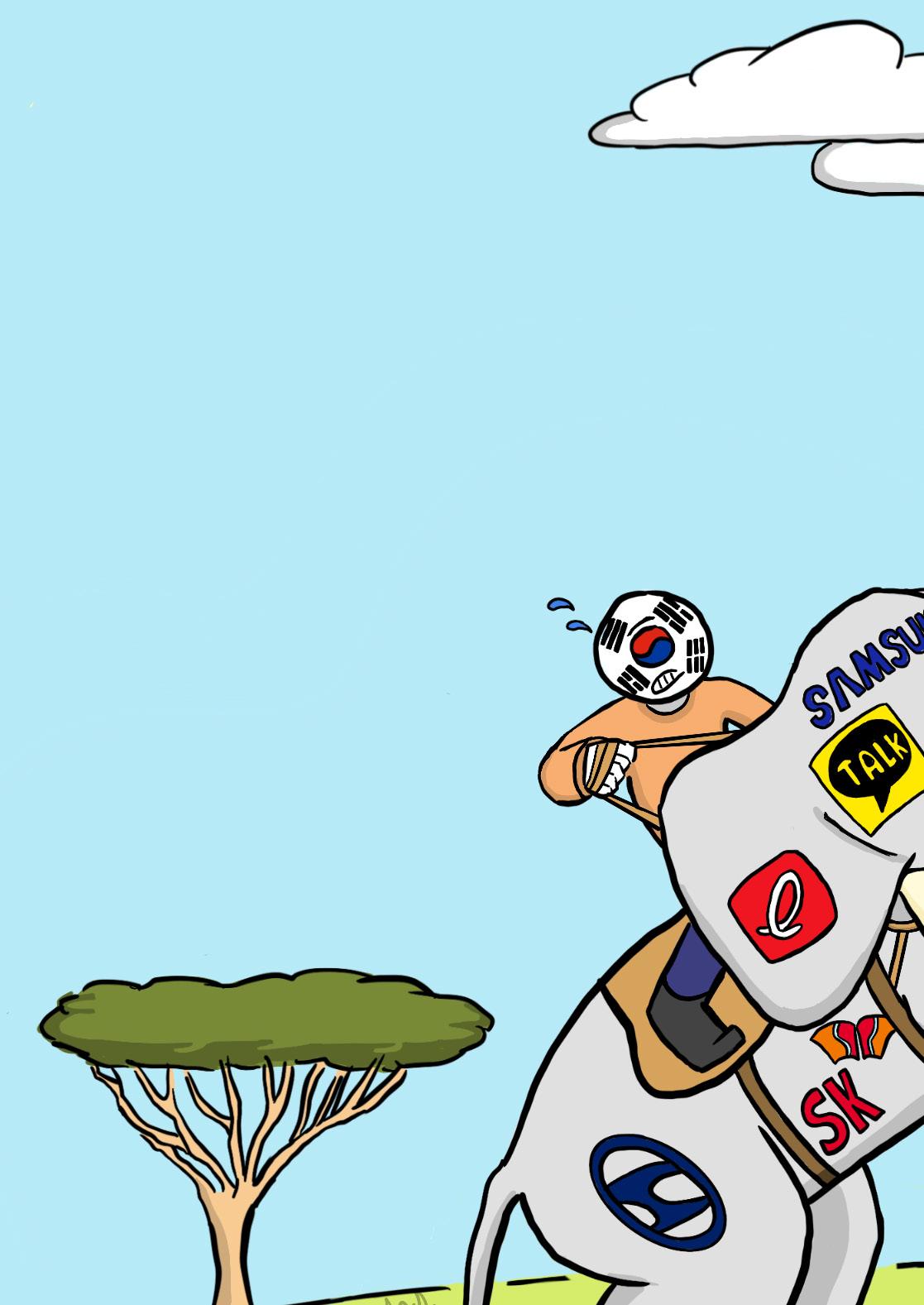
This close relationship has led to numerous instances of political corrup tion, such as Samsung chairman Lee Jae-yong’s arrest in 2017 on charges of embezzlement and bribing former pres ident Park Geun-hye. The incident was more harshly criticized when Lee was released after less than a year in prison, though some defended his early release by claiming that imprisoning the Samsung chairman could potentially have disas trous impacts on the economy.
Many also share concerns over the chaebols’ destruction of their competitors to maintain profits. For instance, part of Park Chung-hee’s pro-chaebol policies also included laws that encouraged chaebols to take over smaller companies, claiming that he wanted to remove “unsound busi nesses” from the Korean economy.
Despite these controversies and criti cisms, chaebols have still played an unde niably important role in developing the South Korean economy and strengthening the nation’s stance in the global market.
Samsung, the largest chaebol in Korea, accounts for 20.3 percent of the nation’s GDP, and its affiliate Samsung Electronics employs over 300,000 employees globally, an even greater number than its West ern competitors, Apple and Google, who employ 123,000 and 88,000 employees respectively. In fact, approximately half of the total South Korean stock market value is represented by the top five chaebols— Samsung, LG, the SK Group, Hyundai, and Lotte—demonstrating their role as a pow erful driving force in the Korean economy.
However, critics do not solely criticize Korea’s dependence on these chaebols and their tendency to be corrupt; in fact, the various safety hazards that have resulted from this economic system are often cited to be its largest downside.
This issue stems from the previously mentioned government support for large businesses throughout Korean history, some of which was dedicated toward allowing companies to bypass certain
regulations when releasing products or building infrastructure. Done for the sake of increased business productivity, these policies often caused numerous safety issues that often led to death and injury.
The most infamous example was the collapse of the Sampoong Department Store on June 29, 1995, which killed 502 people, injured 937, and still remains the largest peacetime disaster in South Korean history. The incident was caused by several irresponsible decisions that were made when constructing the build ing, as well as the blatant disregard for following federal safety procedures, such as embedding only eight of 16 required steel reinforcement bars and ignoring cracks in the building’s ceiling. It was later revealed during a criminal trial on Dec. 27 of the same year that city official Lee Chung-woo and area chief Hwang Cholmin had been accepting bribes from the building’s owner, allowing him to bypass these safety regulations.
As the decades-old issue of Korea’s reliance on monopolistic businesses con tinues to be brought up in Korean public discourse, the history behind the argu ments made by both critics and support ers of chaebols has helped Korean citi zens take a stance on the issue, leaving many to wonder what the future may bring for the South Korean economy.
The meltdown of the South Korean internet behemoth Kakao has wreaked unprecedented havoc on Korean society. Service disruptions on Oct. 15 engendered socioeconomic chaos, and its aftermath still reverberates throughout the country.

With the company’s tight grasp on some 97 percent of South Koreans, Kakao owns a vast ecosystem of apps and services rang ing from text messaging to online banking, reading, gaming, and shopping. Its messen ger app KakaoTalk alone sustains 43 million users, and Kakao Mobility dominates more than 80 percent of the nation’s taxi-hailing services. Hence, when Kakao’s data center was engulfed in flames, millions were left stranded without access to apps they had been relying on, while thousands of busi nesses using Kakao to connect with their customers were greatly inconvenienced.
Laying bare the fractures in Korean society that have been deepening for decades, this episode begs the question of whether or not Kakao’s monopoly in mobile services poses a risk to Korean society and what the future holds for monopolies in Korea.
But first, to understand South Korean monopolies, it is crucial to have an under standing of the chaebols—large fami ly-owned business conglomerates, such as Samsung, LG, Hyundai, and the SK Group— that are usually considered a crucial ingre dient of South Korea’s economic miracle.
Powerful chaebol families use complex cross-shareholding, circular-sharehold ing, and nepotism to maintain control over the companies. They have long resisted reforms to their ways of monopolizing markets, using their weight of over 80 percent of South Korea’s GDP to prevent any forceful government changes.
However, while the fortunes of the few have reached unprecedented levels, earn ings for the average worker have barely changed, leaving many Koreans with no cushion to absorb the force of the current economic downturn. Furthermore, the handful of companies that face little com petition have no incentive to deliver better products or to increase efficiency: they simply rake in cash from those who have no choice but to hand it over.
Experts claim that the South Korean economy will require major corporate reform to limit the inequality caused by monopolies and create sustainable growth. Precedents indicate that the country could have easily avoided the Kakao mishap with countermeasures to curb the overreliance. The US and EU have been working to fix these online monopolies for years; for exam ple, the US Congress packaged and passed multiple related bills in June last year—one being the Ending Platform Monopolies Act. This act prohibits large online platforms, as designated by the Department of Jus tice or Federal Trade Commission, from offering certain products or services from another line of business that is owned or controlled by the platform. By protecting small businesses across the country by leveling the playing field, restoring fairness and competition, and allowing innovation to thrive, this act presents one of the many approaches Korea could potentially take to tackle this issue.
Nonetheless, Kakao cannot deflect criti cism for having failed to take on its respon sibility as a platform giant with far-reaching impacts on the daily lives of all—if not a great majority of—Koreans. According to the Korean government’s Fair Trade Com mission, the incident, to some extent, was
a result of the nation’s dominant platform failing to make reform efforts and neglect ing its social responsibility.
The commission expressed its intent to adjust the specifics of a law whereby online platform operators will be penalized for abusing their market dominance. This announcement came on the heels of South Korean President Yoon Suk-yeol’s comments regarding the need for government action to reorient the market heavily distorted by monopolistic or, more commonly, oligopo listic practices, especially when the public exclusively relies on the infrastructure offered by a single market player like Kakao.
President Yoon said the government would examine the dominance of Kakao's services as they were “like a fundamental national telecommunications network as far as the public is concerned.” If the market is distorted in a monopoly or severe oligop oly to the extent where it serves a similar function as national infrastructure, the gov ernment should take necessary measures for the sake of the people.
With many pointing out that the exces sive market dominance in Korea must be corrected, a South Korean version of the Ending Platform Monopolies Act may take form upon confirming the risk of monopo lies after the shutdown of Kakao. As Korea continues to grapple with such issues, many are left to wonder what the future may hold for the country and its reliance on monop olies.
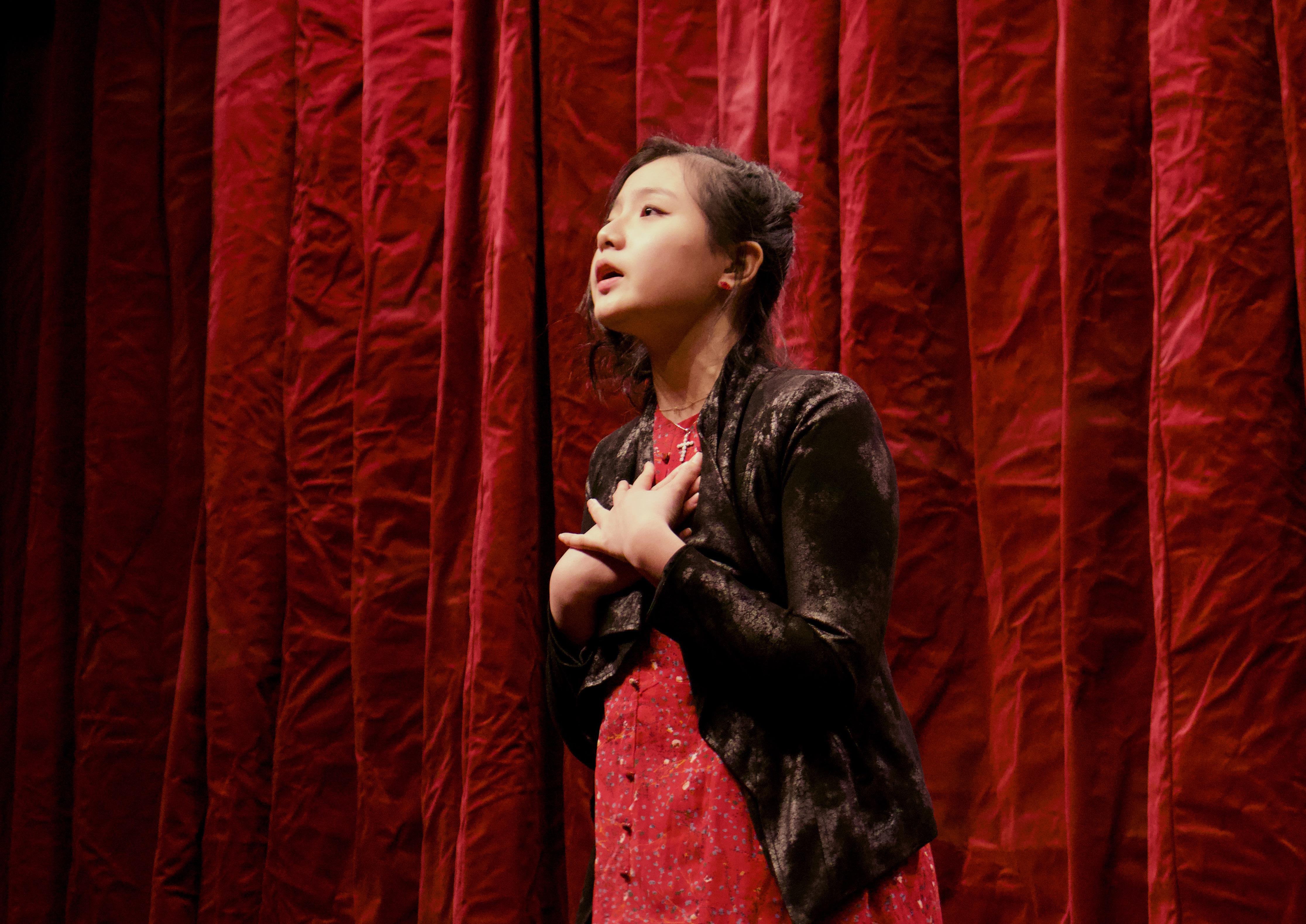
A star of the SIS drama depart ment for years, Jennah Yoo (12) recently closed her act at SIS with her seventh play: “A Midsummer Night’s Dream.” She performed as Helena, a romantic protago nist pursuing an unrequited love with Demetrius. Last year, she performed as the narrator and Adella the mermaid in “Mythical Creatures and How to Approach Them.” In 2020, Jennah was God father Dross in “The Nutcracker.”
Now a seasoned performer who inspires others onstage, Jennah began her journey as an actress in sixth grade with her sister, Hannah Yoo. Already part of Drama, Hannah convinced Jennah to audition for the play “Get Smart.”
Jennah auditioned and made her debut on stage as the Tea Shop Customer and Dancing Bug. She continued to participate in school plays every year, and the stage soon became a natural place for her.
“I love acting because it allows me to be someone that I am not in my normal life,” Jennah said. “By eighth grade, it just became natu ral for me to be in the next play. Not only did I like being part of such a
big school production, but also it helped me with public speaking and stage fright. I wanted to foster my communication skills, which has now brought me to doing Drama for seven years.”
Jennah’s biggest challenge was being overwhelmed by stage fright whenever she auditioned for a new role. Every time she stepped up on the stage, fear would prevent words from coming out of her mouth and wipe her mind blank. But Jennah did not let this stop her.
“The first director that I worked with, Mr. Arthars, taught me how to overcome stage fright,” Jennah said. “It is a simple technique: tell ing yourself, ‘once I step on stage, this is not me, it is my character,’ repeatedly before going on stage. Now I use this method not just when I have to perform, but also when I have to make a presentation in classes.”
Another challenge actors like Jennah often face is that the role may overshadow the performer. Despite pouring hours of time and energy into the production during a busy semester, school play actors often do not receive substantial
acknowledgement for their efforts. That is why Jennah felt the most accomplished when people recog nized Jennah on stage as Godfather Dross in “The Nutcracker,” despite a huge wig covering her face, and complimented her stunning per formance.
“Godfather Dross was my first role with many lines,” Jennah said. “The responsibility bestowed upon me was both heavy and special, as most of the other characters’ lines depended on my longer lines. This role felt like a breakthrough because it was an indication that I grew as an actor. I definitely felt a sense of confidence grow within.”
Becoming better at presenting in front of the class and gaining confidence are just some of the many academic benefits that Drama brought to Jennah. Actively participating in the production and interacting with other stu dents from other grade levels gifted her with a new, valuable experience.
“While acting definitely took time off my personal life, it actually enhanced my academic performance because I was able
to form new relationships with upperclassmen,” Jennah said.
“They told me about their high school experience and gave me important advice on how to bal ance my academic life and social life as well as manage stress.”
Leaving a 7-year-long com mitment means several things to Jennah. First, it means there are regrets. Jennah has played a vari ety of roles ranging from mere side characters to the narrator to the main protagonist. In that process, she has acted as characters of the opposite gender multiple times. While this gave her experience to widen her acting spectrum, Jennah also wishes that she could have played more female characters.
Regardless, Jennah feels a strong affection towards all the charac ters she has played. In particular, the most recent Helena from “A Midsummer Night’s Dream” holds a special place in her heart because Jennah spent hours investigating and analyzing the character. She turned each line into her own and immersed into the character more than ever before.
“My most memorable role
would still be Godfather Dross though,” Jennah said. “The cos tume and hair were iconic!”
With all her plays now over, Jennah cannot help but feel bit tersweet. Being part of the produc tion, making the story come alive, and bonding with the cast mem bers were all special moments that she wishes would have lasted for ever. However, this is not the end of Jennah’s career as an actress, as she plans to continue being on stage even in college.
“Drama helps me become someone that I am not in real life,” Jennah said. “Embodying a person ality and a character that is differ ent from my own helps me express my feelings in diverse ways. It helps me understand others who are polar opposites of me. Drama started off as something small, but now it is inseparable from my identity and life. I will definitely be continuing my path as a student actor in university if the chance is given.”
BY: Hannah Kim Senior, reporterAs the leaves turn brown and the air becomes chilly, students are met with the vibrant hues of autumn. Students start to wear layers of clothes not only to combat the icy, nose-reddening coldness but also to enjoy the arguably most fashionable season of the year. While going down the hill to ride the bus, they see children teeming in front of the bus entrance, crunching on the warm autumn leaves to hear the satisfactory crisp. Students and faculty alike cherish the fading aspects of this transitional period between the receding hot, humid summer and the lurking frigid winter. Here are some of their favorite things about autumn.
“During autumn, I like how the leaves crunch. When ever I see dry leaves, I step on them to hear the pleasing sound. That gives me a sense of satisfaction because walking down the streets while crunching leaves makes me feel like I’m listening to my own ASMR. I also like Thanksgiving because it allows us to have a break from school, giving us time to gather with our family during one of the busiest times of the year.” - Ellen Ryu (10)
“When you leave your apartment, or go outdoors, what do you see? You see the colors red, yellow, and orange. I think these colors of autumn, combined with the cool breeze and nice weather, remind us of the warm memories of our youth. Autumn gives me a sort of a nostalgic vibe, and it always makes me happy thinking about the great memories I have shared with my friends and family over the years.” - Joon Ho Kim (9)
“There’s something really appealing about falling leaves to me. But in my opinion, the best thing about autumn is the fashion. Not only does it allow you to wear warm colors, but it also allows you to layer your clothing, making your fashion choices more versatile than summer or any other extreme seasons like winter.”
-Eunie Choi (12)
“My favorite thing about autumn is going to cross-country practice. Not only am I able to spend time with a variety of people, but I also just like cross country and running in and of itself. I especially love buying food from the convenience store with my friends after I run.”

Tobias Choy (11)
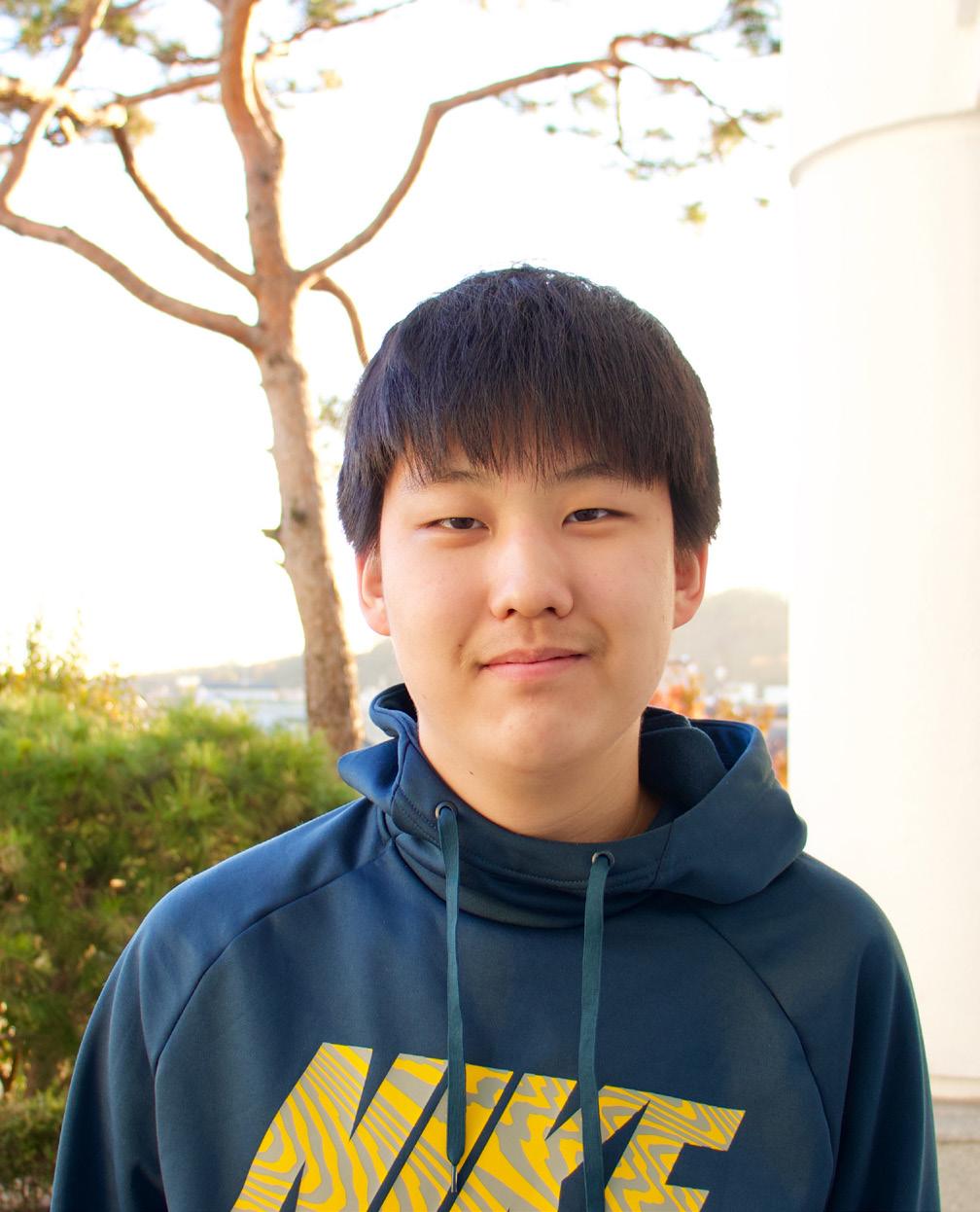

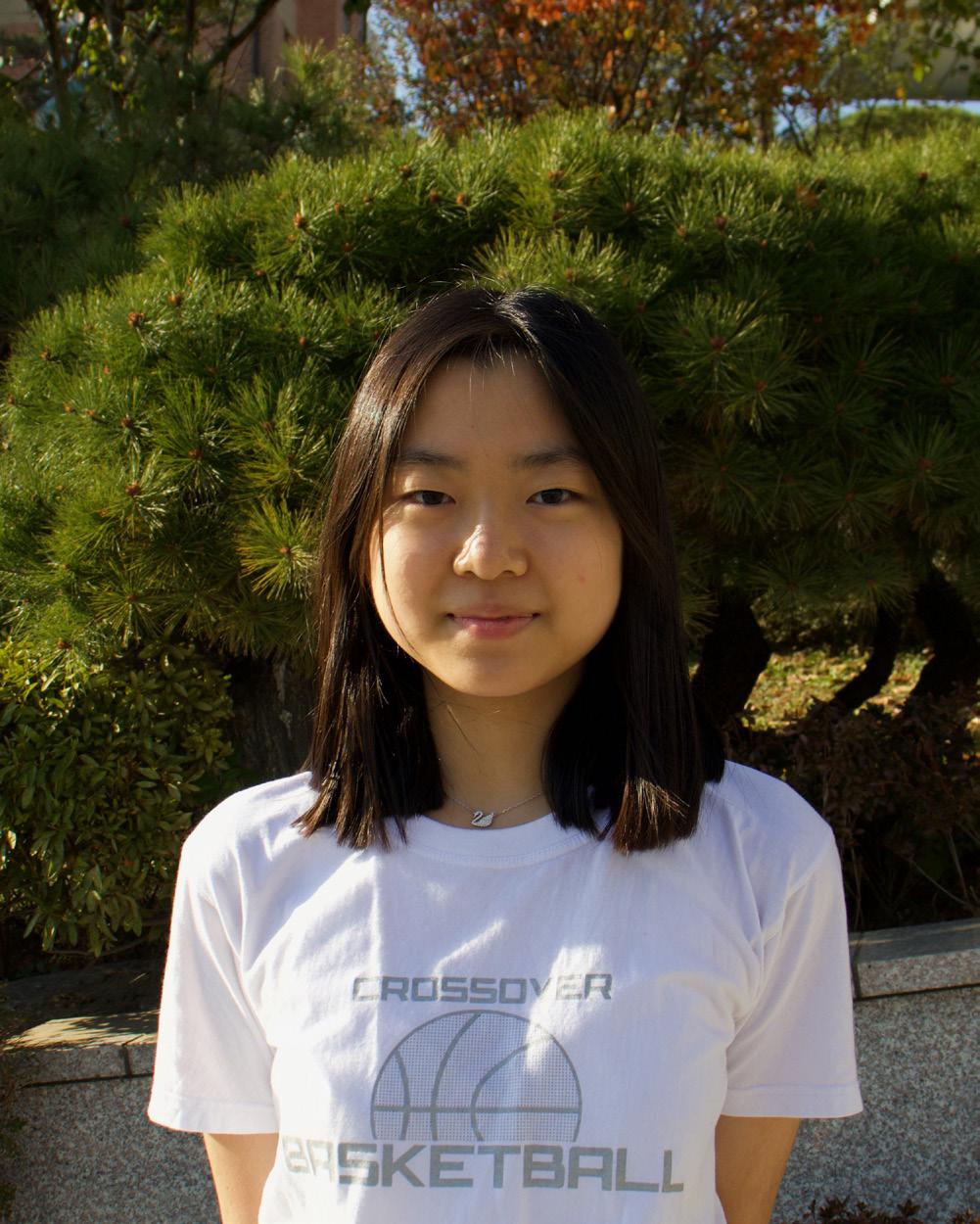

“I really like the cold that autumn brings. I also like it when I walk down the road and see the fallen leaves covered with brown and yellow colors as I look past the sunset. It gives me really ambient feelings and peace of mind. Our lives are so busy with school, and it doesn’t hurt to look around us and enjoy these beauties once in a while.” - Tyler Castaño (10)
“Autumn is my favorite season in Korea. My favorite thing about autumn is the cool nights that finally allow me to sleep an entire night without waking up sweaty. During autumn, I’m always busy catching up with the sleep that I didn’t get during the hot, humid summer, when I can’t sleep even with the air conditioning. I also like how the leaves turn beautiful and the fruits and vegetables change.”
- Tim Gardes, Head of High School Library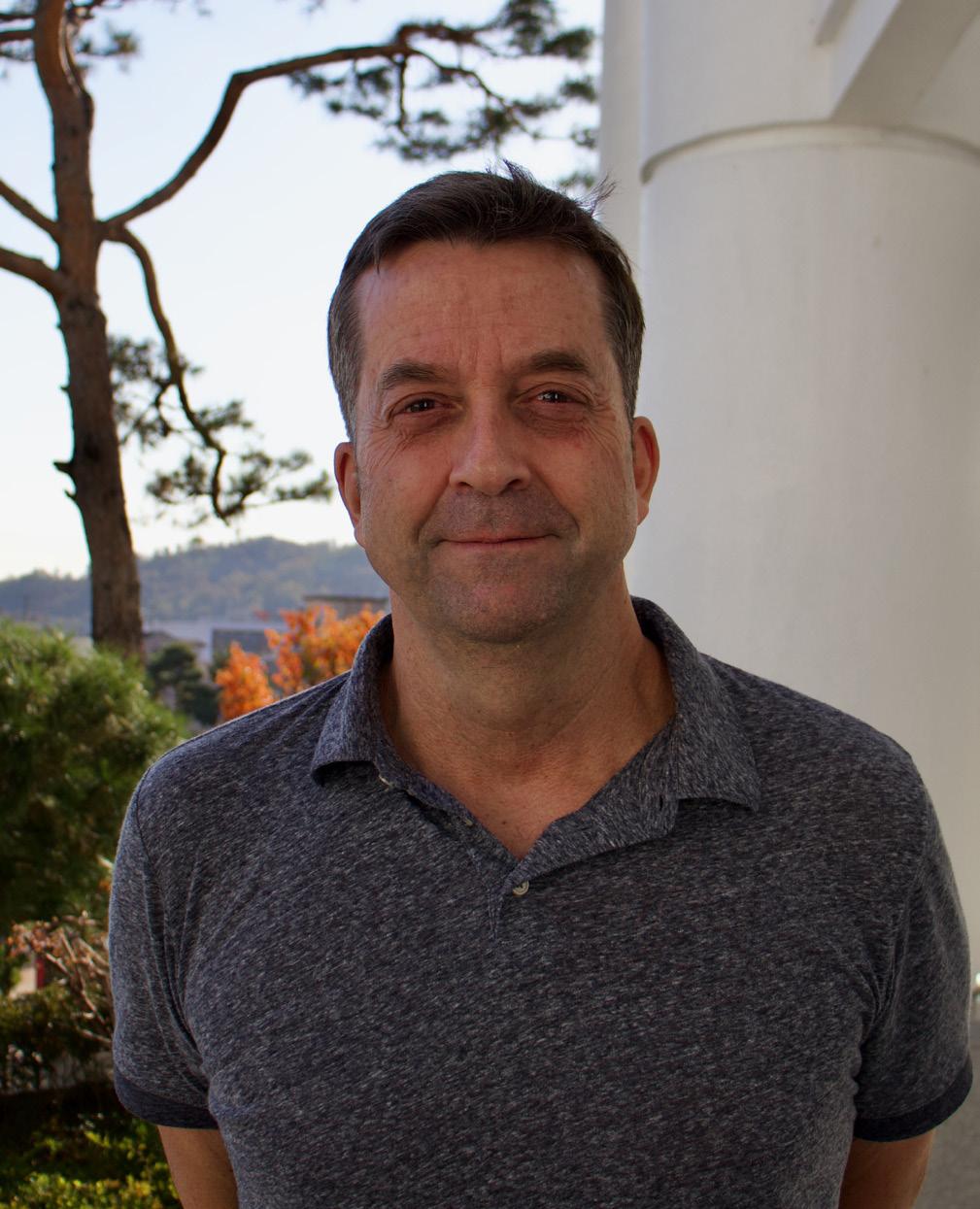 BY: Eric Kim & Jason Shin SophomoreS, reporterS
BY: Eric Kim & Jason Shin SophomoreS, reporterS
In the week following Oct. 29, the nation was found searching for answers. Mothers and fathers stood helplessly in the Hannam Community Center, awaiting officers to men tion the names of their children. The public expressed incoherent emotions, some of anguished frustration at law enforcement, others lamenting younger generations’ cele bration of a holiday that is “not even part of Korean culture.” We ached to know what went wrong, and yet the only answer given was the reality that life takes on seemingly cruel and arbitrary directions.
What was most difficult for us, students, to accept was that Itaewon is a place we our selves frequent and that most of the casualties were those close in age to us. Though heavy events seemed to have become a regular, almost expected part of our news cycle in recent months, the Itaewon incident was one that felt particularly personal—one we could not brush off as a distant tragedy. And though a month has passed, it is still disheartening to search for a silver lining. We simply cannot attempt to shed lights of optimism on a dis aster so fatal without potentially disrespect ing the dignity of the victims and their loved ones, as has been the case for the COVID-19 pandemic.
Memories of the Sewol ferry incident have also been revisiting many, reminding us of the 248 high school students who lost their lives to a sinking many still claim to have unan swered questions. With mass trauma seeming to be on the rise, especially for the younger generations of Korea, we deem it necessary to remind students to reflect on how these tragedies may have affected them. Refrain from viewing photos and videos of traumatic incidents; seek mental health resources; talk to your loved ones.
At the same time, we should remain mind ful of our responsibilities as fellow citizens, with the simplest one being that we must not circulate explicit content from deadly inci dents nor speak lightly on such matters. It has been rather unnerving to hear jokes and victim-blaming from a handful of SIS students the first few days after the incident. While such conversations were likely not meant to be made public statements, they nonetheless prove that some students are yet to understand that civic sensibility and morality begin with the most private, informal dialogues.
As mixed gushes of sorrow, anger, and guilt continue to engulf Korea, perhaps one of the only sources of comfort remaining is that it is up to us how we accept the unfolding of our history: that life is all too unpredictable and unfair to make sense of. While it may be convenient to quickly point fingers at groups of people in times of such unfathomable pain, whether it be the police, the government, for eigners, or even the victims, history has taught us that such a response yields nothing but an air of mistrust in what could be an empathetic, constructive community.
As the year draws near an end, and the nation’s search for answers shows no sign of ebbing, the Tiger Times staff members would like to join victims’ loved ones once again in expressing our deepest condolences for the 158 who had to depart far too early.
embers of the world’s most pop ular K-pop band BTS will serve their mandatory military service, with Hybe Entertainment confirming that the oldest member, Jin, will soon go. This announcement raised controversy among Koreans and BTS fans worldwide, generat ing more attention to the issue of military exemption in Korea.
South Korea–still in constant hostility with North Korea–currently requires all able-bodied Korean men between the ages of 18 and 28 to fulfill military service for 18 months. There are exemptions, none theless, to some globally accomplished Korean men, such as football player Son Heung-min and pianist Cho Seong-jin.
Requirements for military exemption exist in other fields, such as sports and classical music. Korean male athletes who earn an Olympic medal or an Asian Games gold medal and Korean male classical musicians who place within second place in prestigious international competitions such as the Chopin International Piano Competition are also exempt. Though they are given military exemption, the Military Manpower Administration classifies them as arts and sports personnel instead and requires them to complete relevant com munity service.
Because there is no category for K-pop artists in military exemption rules, BTS does not qualify for exemption despite their immense fame and presence on the global stage. K-pop artists who achieve
international fame on criteria similar to the accomplishments of BTS should not be required to serve in the Korean military, and they should receive similar treatment as athletes, classical musicians, and other artists recognized by the Korean govern ment. Though it may be difficult to create a new requirement for K-pop artists to be exempt, the indubitable global popularity of BTS–possibly even more famous than other globally accomplished Korean men–should not be dismissed.
One of the most defining elements of Korean culture and identity, the K-pop industry not only helps promote global interest and admiration for Korea but also provides a reliable source of eco nomic wealth. For example, BTS brings Korea approximately $5 billion every year, according to NPR. In other words, BTS members could have brought around $7.5 billion of profit to Korea if they were not required to enroll in military service that lasts around 18 months.
The 18-month period of military ser vice may also be too long of duration for K-pop idols, especially as K-pop empha sizes youthfulness. Most K-pop idols peak during their early 20s, a time that overlaps with when Korean men enroll in the mil itary, and idol groups tend to lose their profitability and fame when they age.
K-pop artists may change their career plans during their military service, making their future unpredictable. Not only would K-pop artists lose their fame due to absence
in the global stage for 18 months, but fans may also feel downhearted about changes in K-pop idols and their plans when they are released from military service. Though BTS members officially stated they will reconvene in 2025, the world would be dev astated if they change their initial plans.
One way the Korean government can grant K-pop artists military exemption is to set a requirement of earning the top awards from Billboard, a prestigious music publication. For instance, K-pop artists who specifically acquire a top Billboard Music Award–Top Artist, Top New Artist, Top Male Artist, or Top Duo/Group, which BTS has already won three times–under all genres or a Best New Artist Award from the Grammy Awards could be exempt. This requirement would similarly reflect the current conditions for athletes and classical musicians who must achieve the highest title in global competitions.
As K-pop establishes itself as a much-be loved genre of music across the world, the Korean government should recognize the value of K-pop artists. Just like how an audience member should not distract the performer, the Korean government should allow globally successful K-pop artists to continue their performances on the global stage without interruptions to their career.
direct teacher advice, which may then change the social stigma over meeting with teachers outside of class.
However, time restraints during class time could pose a problem for teachers, and without a structured reflection, students could possibly be lost to know where to start in their discussions and less motivated to participate. In this case, conferences outside of classes could be held with a determined schedule with the days the students will be meeting during office hours, activity period, before school, or after school for them to ask questions and have their reflection conversation take place without time pressure.
Let yourself be heard. If you have any responses to articles published in the Tiger Times or original contributions, please send them to tigertimes@gmail.com
Reflections are often assigned after summative assessments including pro jects, tests, and discussions. By probing students to reflect on the successes, fail ures, and challenges of the unit, reflec tions mark an end to the unit of study. However, the reflection assignments that are currently implemented in classes do not always enhance students’ interac tions with summative assessments.
Currently, while teachers use reflec tions as resources to guide the thinking process of students and to provide a structured reflecting moment because without reflecting there is no learning, many students see formulaic reflections as tedious assignments that are done for the sake of a grade.
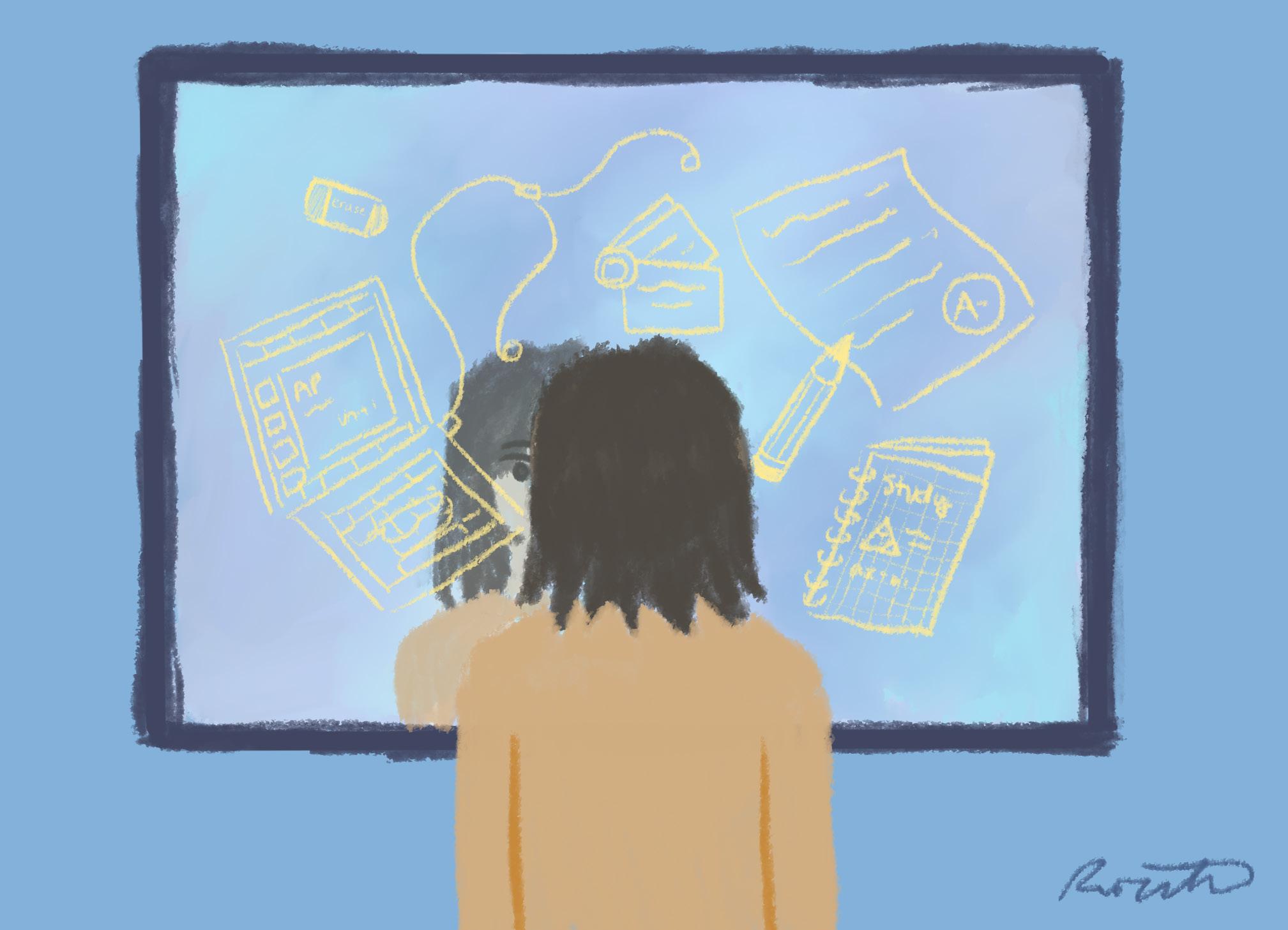
End-of-unit reflection writing com ponents usually encourage students to look back at the challenges they faced and consider ways to avoid them in the future. But these reflection prompts limit students from fully expressing them selves and seeing reflections as a true learning experience instead of simply
answering questions. To allow every stu dent to benefit from such reflections and take reflections seriously, teachers could consider implementing more interactive and collaborative reflections instead.
These reflections could happen in a more open environment through discus sions, where students could learn new perspectives on group work and develop better social skills as a result of listening and interacting with others. Collabora tion between group mates could allow them to give feedback to each other, which would become more oriented toward how the students, as a group, reflect on the project and their roles in it.
Interactions with teachers are also often limited during class time and stu dents rarely try to meet with teachers outside of class as students often see asking for help as a sign of weakness. Considering this, having reflections in the form of private conferencing between teachers and the students during class time could help students develop a better grasp of their mistakes as they are given
During these reflective conversations, teachers could ask about the specific steps students took to attempt an assign ment, what were their concerns or strug gles with the assignments, and what ways they would attempt or have attempted to overcome them. Unlike Q&A or promptbased reflection where there is more room for a generic response, the discus sion would prompt students to be more honest and sincere by providing detailed responses through the discussions.
Teachers’ purpose in making reflec tions is well-intentioned by creating a space, even if it has to be in the form of a grade, to force students to slow down and look back on their work.
Still, some students would choose not to take them seriously and would just see them as easy grades, when in reality, authentic reflections are important to our learning experiences.
Therefore, to demonstrate the school’s value of learning beyond the simple numeric grade, reflections could become more than mere formulaic assignments for students. Learning is a continuous process and frequent reflections are where students improve their learning. If students and teachers can actively use reflections as a tool for interaction and a clear resolution of what to improve, reflections could become turning points for the student’s learning journey.
The food waste epidemic has gotten out of hand globally, including at SIS. With the school wasting over 100kg of food on average a day, an urgent solution to this problem is necessary.
How does the food waste problem negatively affect the school?
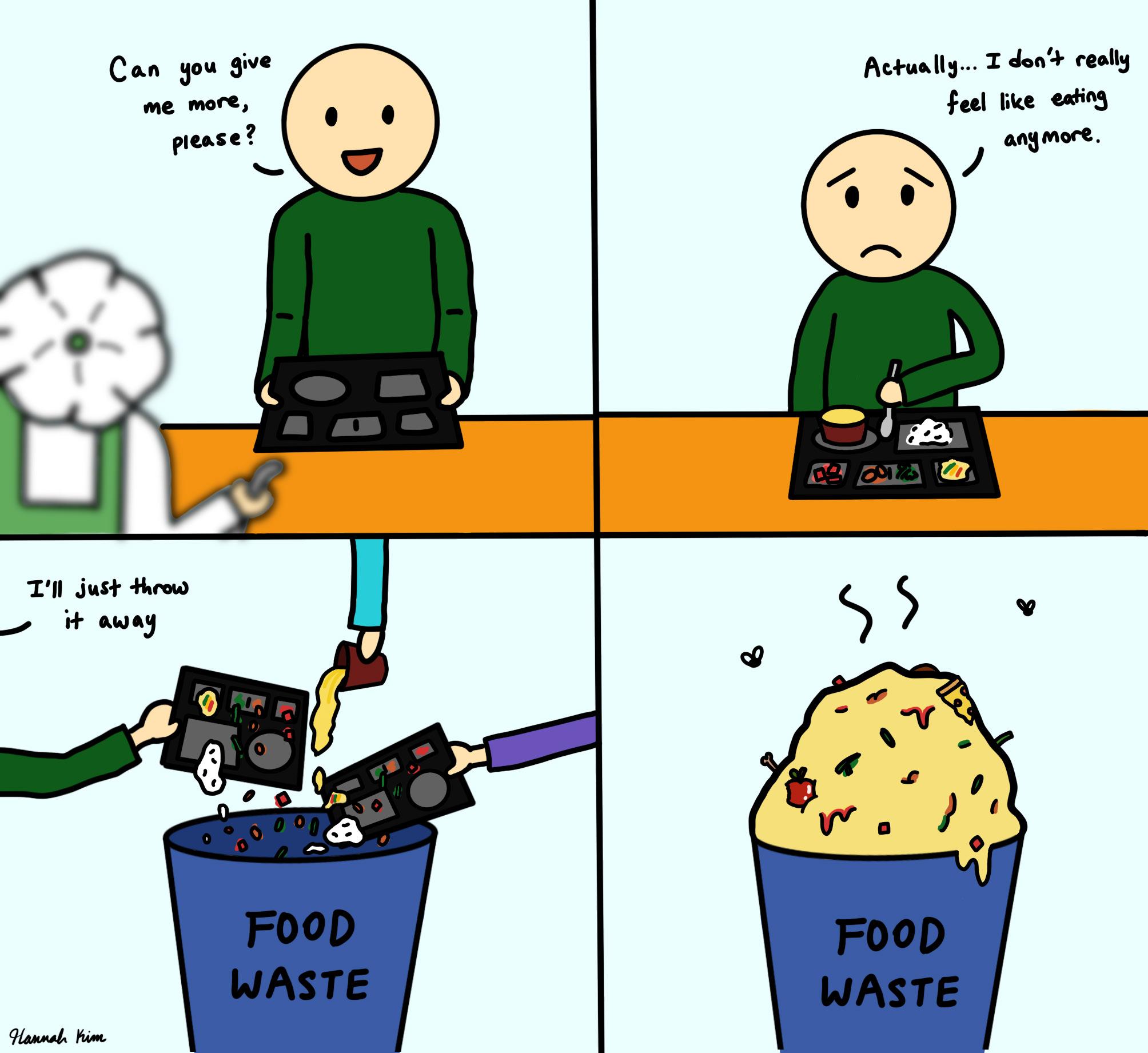
What can students at SIS and the school itself do to limit food waste?

As Qatar is scorched by 48 degree Celsius temperatures and once-in-ahundred year storms become once-ayear occurrences, it is more clear than ever that major strides must be made towards sustainability. One of the easiest ways to create a more environ mentally friendly society starts with addressing the problem of food waste. Food waste is a problem that has gotten out of hand globally. As of 2019, school food waste amounts to 530,000 tons per year amongst US schools, which costs $9.7 million to manage. The food waste issue also plagues SIS.
As of 3 years ago, between the ele mentary, middle, and high schools, SIS wasted an average of 200-250 kg of food daily. That is enough food to feed an average four-person family for around a month and a half. To SIS’s credit, the food waste problem has gotten better as the school has diversified and improved the taste of lunch menu options, result ing in fewer people wasting their food overall. However, there is still work to be done. The school still wastes 100 kg of food on an average day, according to Hye-won Park, the manager of J&J’s cafeteria at SIS.
This waste of food is still regrettable, as it inadvertently leads to an array of other problems. Food waste releases methane gas—an extremely potent greenhouse gas—especially when it is
stored in large amounts. The transport ing of said waste creates more harm to the environment, as often diesel-pow ered bio-waste disposal trucks must be called in to handle the waste. Further, the more our school relies on these waste management companies, the more money is spent on managing food waste that could be saved if this issue was preemptively solved.
Obviously, the easiest way the school can reduce its waste is for the students to finish the food that they take. How ever, students are unlikely to completely eliminate their food waste. So, what can the school do to help alleviate the problem? One of the more feasible solu tions is creating smaller serving sizes in the cafeteria. This would ensure that any student who does not finish their food would waste less of it and that any student who eats more than the smaller serving proportion could simply get a second serving.
Dividing the contents of a lunch plate itself can also work to minimize food waste. That is, the cafeteria should sep arate the different parts of each menu option, such as by keeping the rice in a small plate separate from the meat in another small plate. The Korean lunch menu option has already employed this strategy, as they keep all of the side dishes separate from one another in smaller plates, and then have one larger
bowl for the “main course.” However, the other two menu options that the cafeteria provides are usually not sepa rated, containing one large plate with a multitude of different foods. If the caf eteria were to divide all of the different sections and food groups of each menu option into such smaller containers, the students would be better able to choose only what they want and not others that would end up as waste.
Also, a more conscientious way of disposing of this food waste can be beneficial. Instead of solely relying on diesel-powered trucks to take away the food waste, SIS can utilize composting strategies to efficiently repurpose food waste on campus. On the roof of the school’s high school building, there is a greenhouse. However, the greenhouse is used by few students and teachers at SIS. If the school were to set up a composting bin in the greenhouse, not only would this be a green way of repur posing school food waste, but it would also make gardening more productive for those who use the greenhouse.
It would also be beneficial if certain clubs, such as GIN or the Green Club, gave presentations and instructions on how students can minimize their food waste. This would look like going from classroom to classroom across the ele mentary, middle, and high schools to give presentations and educate students
on the adverse effects of wasting their food. These presentations could also include further tips as to how students can limit their waste outside of school. While this would not eliminate food waste altogether, it has the upside of being one of the most feasible courses of action to get the student body involved and informed on this problem of food waste.
Food waste is a major contributor to CO2 emissions but it can be one of the easiest problems to solve with the right mindset and policies. However, a large part of solving this problem also lies on the students themselves. The student body needs to be more mind ful of the food that they waste and its potential effects on the environment. Students also need to take responsibil ity in changing their wasteful habits, and should try to minimize the amount of food that they waste by only taking as much food as they think they can finish. For example, students can take the initiative in communicating with the caterers so that they can get more or less of a particular food. In the end, as our mothers always admonished us to do, we must finish our plates clean if we have any hope of going green.
by: Jason Lee Sophomore, reporter…is a racially derogatory term used to insult African Ameri cans. For the sake of clarity, this article in no way endorses the use of racial slurs in any form and believes that the final discre
tion of the word’s use should be dictated by African Americans. The purpose of this article is to simply inform readers of the word many students come into contact with in the media.

Our lives often feel too overwhelm ing to catch up with the music of society. There are expectations set in stone and we find ourselves drawn to a faster tempo. We often feel obliged to play along with everyone else as if we were an orchestra, and keeping to our own rhythm is often seen as unde sirable.
“Whiplash,” a 2015 Oscar-winning film, takes place at the Shaffer Con servatory, a prestigious music school in New York City. Andrew Neiman is an ambitious first-year drummer aspiring to be like the great Buddy Rich, one of the most influential drummers in his tory, and be a part of the Conservatory Studio Band led by the great yet tyran nical Terence Fletcher.
When he lands the part as the new drummer of the band, Andrew is determined to catch up with Fletcher’s tempo and play the song “Caravan” impeccably. In pursuit of this goal, he pushes himself—even to the extent of making his hands bleed. He loses control of his emotions and ends up breaking up with his girlfriend to focus all his attention on drumming.
Ironically, his ambition to be the greatest drummer leads to his downfall as an artist as his obsession with excel lence causes him to lose his sanity. After arriving at a performance late because of a car crash and attacking Fletcher out of frustration, he loses his position as the main drummer and gets expelled from the Shaffer Conserva tory. Fletcher also gets laid off after Andrew reveals his abusive teaching methods.
Even after the severe abuse he endures, Andrew gives drumming another shot with Fletcher’s new band. By giving Andrew the wrong music sheets, Fletcher tries to sabotage Andrew’s performance and humiliate him in front of the audience. However,
By Ian Parkas the music starts with a different rhythm, Andrew takes on the per formance with his own tempo, start ing with the song “Caravan.” Then, everything changes for him as he leads the band into his own music world.
Just like Andrew, students pursue their own academic endeavors even when it means desperately keeping up with the ever-increasing double-time swing tempo of their day-to-day lives. We rarely reflect on the emotional turmoil and hardships of overcoming disappointment or choose alternative pathways or solutions.
In a wider scope, expectations held by society as we enter the brink of adulthood are prioritized over the tempo of our hearts. Conformity silences students from searching for their own path and the loud booming tempo prevents creative minds from creating their own innovative music.
After being expelled, Andrew finds time to recover from the extreme pressure imposed by Fletcher. Through this, Andrew does not let himself down on the day of the big performance. Andrew starts with the songs he knows, the tempo and timing he is accustomed to, and finally starts to drum for himself.
While the act might seem rebellious, what matters is that Andrew did not let the various tempos used by people affect him. Not everyone learns, thinks, or spends their time the same way, therefore preventing individuals from pursuing their own tempo of life will hinder societal growth.
Fletcher used to say “not quite my tempo” when criticizing Andrew for not drumming to his expectations. But when Fletcher realizes that Andrew has found his independent spirit to drum out his soul with a passion never seen before, Fletcher smiles for the first time.
…is rampant in the media. A word that is equated to systemic oppression is now found in a majority of hip-hop songs. Even in mass media, it is common to hear such terms ex changed by those who have no real authority to use the word, such as by white people and Asians—as if the word never held a history of persecution. The hip-hop artist Kendrick Lamar once invited a white woman from the audience to join his performance during his good kid, m.A.A.d city tour, but then stopped her when she did not skip over the n-word, which recurred 21 times in the lyrics. It was off-limits to her, and she was eventually booed off the stage. Moreover, beyond just songs, social media plat forms like Twitter have seen the rise of such slurs increase. Just hours after Elon Musk’s acquisition of the platform, media watchdog groups found that the use of the n-word had increased by nearly 500 per cent on Twitter, raising con cerns about the proliferation of hate speech under the pretense of free speech.
…is a way for the oppressed to reclaim their past.
As language shifts, words take on new meanings. Hence, some argue that the reclama tion of racial slurs leads to eventual closure through ca sual use. For example, other slurs too have been reclaimed such as the derogatory term for women in casual contexts, or the LGBTQ community’s reclaimed slur, “queer,” which is now sometimes used to ex press endearment for others. Yet whenever used, the word carries a significant weight that should be carefully considered before being used flippantly and, most definitely, by those who have no cultural connec tion to the word at all. Surely, it is important to remember the complicated history that birthed the word into existence.
…involves social and semantic norms that no individ ual can simply override.

For over two hundred years, this word was weaponized by white people to demean Afri can Americans and hinder the civil rights movement. The ca sual use of such highly-charged words, then, may either delib erately or inadvertently con done those words—which is not acceptable as it harms Af rican-Americans when used as a derogatory insult and sends a message to others that they, too, could be targeted next. Without being aware of the heavy social implications this word carries, this may then lead to an escala tion of hate, bias, and injustice in society. Though not impos sible, the separation of a word from 300 years of historical context is difficult to achieve in the span of a few years.
…contributes to historical insensitivity.
Words have power because they are more than their dictio nary definition, and the history behind them matters as long as the effects of that history are still felt. The n-word has been historically significant in being the main derogatory term for African Americans ever since the institution of slavery began in the United States. Centuries of contempt and denigration accompany the word. When it comes to the normalization of this word through song lyrics, it is questionable as to whether the positive reclamation of this word is truly happening. Some claim that this reclamation has resulted in non-black teenagers who listen to hip-hop flippantly using this word without recog nizing its history.
Nonetheless, the constant discussion around reclaiming the n-word suggests that the public will always have complicated re lationships with the word—but that non-black students at SIS must sit this debate out as passive consumers of media and thus refrain from its use.